As a dog owner, you have been a victim of those pitiful eyes of your dog asking for food that you were eating on your table and ended up feeding them, he/she cannot feed everything on the table to their dogs.
Generally, dog owners know what not to feed their pup and end up crossing out most of the things on the list. This can lead to a boring diet for your dog.
Hence we have come with this post about Human Foods Dogs Can Eat Too!
You might already know that controversial dog food like Chocolate, Garlic, Grapes, Raisins, Caffeine Products, Avocados, etc. should not be anywhere near a dog.
Also, if you feel you cannot remember all this stuff as we are going to discuss almost every category including Fruits, Vegies, Snacks, Meat, and Dry Fruits, you can download the infographic at the end and keep it handy on a refrigerator or just note down everything.
Now, let’s learn what human food dogs can eat, starting off with fruits but before that let’s understand how many calories can your dog eat
Any food with the compound Xylitol in it is harmful for your dog. Xylitol is a sugar substitute which works fine for humans but for dogs it’s a nightmare! Some foods which contain xylitol are Peanut butter, Sugar-free candy, Fruit drinks, Jello, etc.
A handy tip is before feeding anything sweet, check if it contains Xylitol or not.
Table of Contents
How Many Calories Should Your Dog Eat In A Day?
Use this calculator or calculate manually by using the following method by PetMD.
The standard steps used by veterinarians to determine a dog’s caloric needs are as follows:
- Divide your dog’s weight by the number 2.2 to get it in kilograms.
- Energy Used For Resting (EUR) = 70 (body weight in kg)^0.75.
- Energy Required For Maintenance (ERM) = appropriate multiplier x EUR.
Commonly Used Multipliers:
| Normal Neutered Pet | 1.6 |
| Normal Intact Pet | 1.8 |
| Weight Loss | 1 |
| Weight Gain | 1.7 |
| Light Work | 2 |
| Medium Work | 3 |
| Heavy Work | 6 |
| Growth (Less Than 4 Months Age) | 3 |
| Growth (More Than 4 Months Age) | 2 |
Her is how the calculations for a neutered dog who weighs 50 pounds look like.
- 50 lbs / 2.2 = 25 kg
- 70 x 25^0.75 = 783 kcal/day
- 1.6 x 783 = 1252 kcal/day
Guideline to Follow Before Feeding Human Foods To Dogs
It is good to skim through the following guidelines before feeding any of the above Human Foods Dogs Can Eat:
- Start with small portions and notice the stool and behavior of your dog after eating a specific food item. Only go ahead if everything looks good.
- You may use Slow Feeders to decrease the eating speed of your dog. Slow Feeders ensure that your dog does not gulp down the food all at once but rather eat small portions at a time.
- On your next visit to the vet, you should ask whether the food items added by you are good or should be avoided.
- If your dog is diabetic then any modification in the diet should go through your vet.
- Serving snacks should be in the ratio of 90/10 calories, 10% calories from snacks, and 90% from other dog food.
- While serving anything hot make sure that the temperature is not boiling hot, it should come down to room temperature for dog your dog to eat or drink it.
- Any food item with high fat, salt, or sugar content is bad for your dog. Eg: Butter, Salted Popcorn, jam, etc.
- Always check the ingredients list before you feed anything to your dog. Beware of compounds like Xylitol, BHA/BHT, White Flour, Artificial Colours, MSG, Corn Syrup, Other Sugar Alcohols, Nitrites or Nitrates.
- Wash non-organic produce in apple cider vinegar.
- Never feed bones or uncooked meat.
Fruits Dogs Can Eat

When you think about what fruits you can feed your dog, you almost end up doubting every fruit. But here is a list on which you can rely lifelong which takes away all the guesswork.
All fruits should make up only 10% of a dog’s daily diet or daily calories.
Bananas

Bananas for dogs in moderation are good.
They are high in potassium, biotin, fiber, and copper and also high in sugar. You should avoid feeding them in excess, especially for diabetic dogs.
| Parameters | Answers |
| Calories | 100 Grams – 89 Calories 1 Medium – 105 Calories |
| Permissible Quantity Per Day | Half a day |
| Diabetic Friendly | No |
| How To Serve? | 1. Freeze small pieces and serve 2. Mash them and add to dog food 3. Mix them in a treat recipe |
| Signs of discomfort | Restlessness, Whining or Yelping, Dilated Pupils and panting |
Apples

Apples can be fed to dogs without any worries and are by far the best thing on the human foods dogs can eat list.
Apples have Vitamin A & C in them and are low in fat.
While feeding them remove the seeds to avoid choking.
They act as excellent low-fat snacks if served frozen.
| Parameters | Answers |
| Calories | 100 Grams – 52 Calories 1 Cup Chopped – 65 Calories |
| Permissible Quantity Per Day | A slice or two of apple per day |
| Diabetic Friendly | Maybe (Consult A Vet Before) |
| How To Serve? | 1. Frozen apple 2. Cut it into slices or pieces 3. Apple pretzels |
| Signs of discomfort | Bellyache and Diarrhea |
Berries (Blackberries, Raspberries, Strawberries) – Senior Dog Friendly

Berries are an awesome fruit to feed a dog in moderation!
They are high in Vitamin C, Fiber, Vitamins, Minerals, and Antioxidants.
Antioxidants help in cellular growth and repair while phytochemicals present in them are responsible for reducing the risk of cancer.
Big berries like Strawberries should be cut in a bite-sized or minced depending on the size of your puppy.
| Parameters | Answers |
| Calories/100 Grams | Raspberries – 53 Calories BlackBerries – 43 Calories Strawberries – 33 Calories |
| Permissible Quantity Per Day | Strawberries – 3-5 (Large Dog) Other Berries- A handful |
| Diabetic Friendly | Yes |
| How To Serve? | 1. Cut it into slices or pieces 2. In a recipe |
| Signs of Discomfort | Diarrhea, Gastrointestinal upset, and Vomiting |
Cantaloupe

Cantaloupe is good in moderation.
It is rich in Vitamin A, B6 & C, dietary fiber, potassium, and niacin.
The fruit’s high water content helps in dehydration and during bad stomach for a Fido.
If your dog shows any uneasy symptoms like Vomiting, Diarrhea, Lethargy, or lack of appetite then the Rind might be creating an issue.
| Parameters | Answers |
| Calories | 100 Grams – 34 Calories 1 Medium Wedge – 23 Calories |
| Permissible Quantity Per Day | A few bite-sized pieces (4-5) |
| Diabetic Friendly | No |
| How To Serve? | 1. Wash and scrub the outer surface 2. Remove the rinds and seeds 3. Slice the melon into small one to two-inch-thick bite-sized wedges |
| Signs of Discomfort | Vomiting, Diarrhea, Lack of appetite, Painful or distended belly, and Lethargy |
Oranges, Clementine & Tangerines

Oranges are rich in vitamin C, potassium, and have low amounts of sodium and fiber, which make a perfect snack for your fur babies.
Although, keep them away from orange rinds as it might lead to choking and also from orange juice as it has high sugar content in it.
Dogs can eat these 2 citrus fruits and the sweetness is not an issue, as natural sugars fed with fiber are safe,” says Stephanie Liff, DVM, and partner at Brooklyn Cares Veterinary Hospital in New York.
| Parameters | Answers |
| Calories | 100 Grams – 47 Calories 1 Medium – 62 Calories |
| Permissible Quantity Per Day | Small Dog – 2-3 segments a day Large Dog – A moderate-sized fruit |
| Diabetic Friendly | No |
| How To Serve? | 1. Remove the rinds and seeds 2. Serve the flesh only |
| Signs of Discomfort | Diarrhea, Vomiting, Dermatitis, Lethargy, Appetite loss, Drooling or Salivating, Nausea, Depression. |
Kiwis
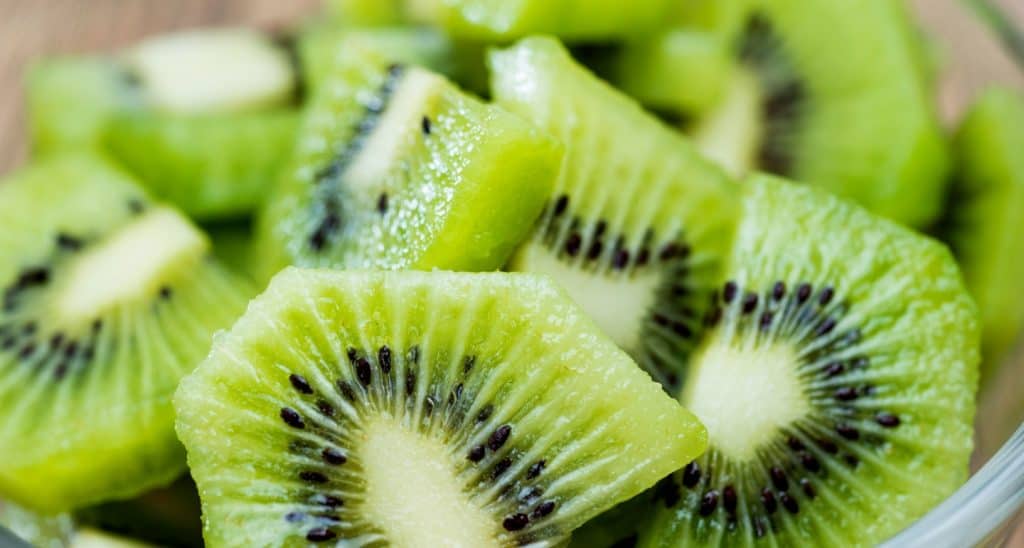
The fuzzy exotic fruit with a green inside is high in Vitamin C and is considered as highly nutritious for dogs. Flavonoids and carotenoids in kiwis are considered as anti-cancerous.
Kiwis due to their anti-inflammatory properties are considered to reduce the risk of hip dysplasia, arthritis, and spinal issues. All these make it a super fruit for dogs.
But, make sure to remove all the seeds and also the skin to be on the safer side.
It is one of the best Human Foods Dogs Can Eat.
| Parameters | Answers |
| Calories | 100 Grams – 61 Calories 1 Cup Sliced – 110 Calories |
| Permissible Quantity Per Day | 1 to 2 kiwis a day |
| Diabetic Friendly | Yes |
| How To Serve? | Remove the skin and seeds and serve the flesh part only |
| Signs of Discomfort | Vomiting, Diarrhea, Lack of Appetite, Painful or Distended Belly, and Lethargy |
Pumpkin

Pumpkin is rich in Alpha Carotene, Calcium, Iron, Lutein, and Vitamins like A, C, and E.
It is considered as a superfood as it treats constipation and diarrhea in dogs. It also helps with weight management.
But do not feed your dog Raw, Canned (With Added Flavors), Gooey Pulp, Skin, or the stem of pumpkin as it might show signs of discomfort in dogs.
| Parameters | Answers |
| Calories | 100 Grams – 26 Calories 1 Cup – 30 Calories |
| Permissible Quantity Per Day | Pumpkin: Adult small dogs: 1/2 – 1 teaspoon Adult medium dogs: 1 tablespoon Adult large dogs: 1 1/2 to 2 tablespoons Pumpkin Seeds: Adult small dogs: (10 lbs. and over) 1/16 to 1/8 teaspoon daily. Adult medium dogs: 1/4-1/2 teaspoon daily. Adult large dogs: 1/2 to 1 teaspoon daily. |
| Diabetic Friendly | Yes |
| How To Serve? | 1. Fresh seeds – Roast at 350 °F for 1 hour 2. 100% canned pumpkin 3. Baked Fresh Pumpkin |
Mango
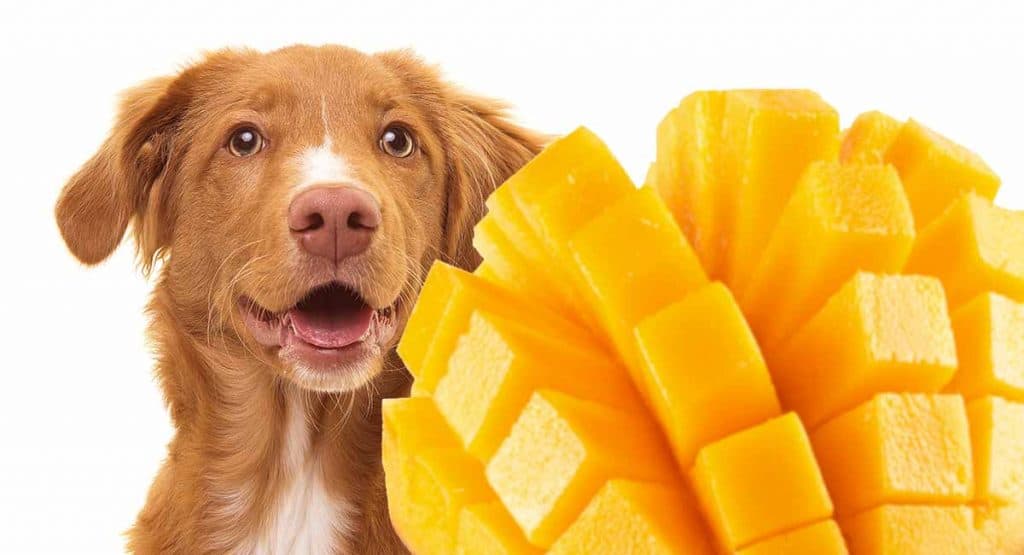
Mangoes are rich in vitamin A, B6, K, and C. It also has fiber in it which will your Fido’s digestive system to function smoothly.
By mango, we mean only the fruit part and not the skin or the pit of it.
| Parameters | Answers |
| Calories | 100 Grams – 60 Calories 1 Cup Sliced – 99 Calories |
| Permissible Quantity Per Day | Adult Dogs – A tablespoon of mango or 2 slices a couple of times week |
| Diabetic Friendly | Yes (Stabilizes Insulin) |
| How To Serve? | Peel the skin, remove the pit, and serve the flesh |
| Signs of Discomfort | Vomiting, Diarrhea, Abdominal pain, Decreased appetite, Straining to defecate, Lethargy. |
Peaches

Peaches are a great source of fiber, and vitamins like A and C. They have a lot of antioxidants packed inside them which proves a good source to boost the immune system thus reducing the risk of diseases like Cancer.
Peaches are high in sugar so stick to 90/10 ratio, 10 being the fruit content in a day.
| Parameters | Answers |
| Calories | 100 Grams – 39 Calories 1 Medium – 59 Calories |
| Permissible Quantity Per Day | Adult Dogs – A tablespoon of mango or 2 slices a couple of times a week |
| Diabetic Friendly | No |
| How To Serve? | Wash the fruit, remove stem and leaves, slice, and remove any stones if there. |
| Signs of Discomfort | Upset Stomach, and Diarrhea |
Pears

Pears are a rich source of vitamins A & C.
Canned pears are a strict No-No! They contain preservatives that are hazardous for your canine friend.
| Parameters | Answers |
| Calories | 100 Grams – 57 Calories 1 Medium – 102 Calories |
| Permissible Quantity Per Day | Small Dog – A slice Large Dogs – 3-4 Slices |
| Diabetic Friendly | No |
| How To Serve? | 1. Cut the fruit into bite-sized pieces, remove the seeds, and serve the flesh. 2. Blend peer with yogurt to create a smoothie, or pour this into ice trays to get a frozen snack. 3. Freeze chunks of pears to make a frozen snack for summers. 4. Grate on regular dog food to make it more interesting |
| Signs of Discomfort | Choking, vomiting, and lethargy. |
Watermelon

Watermelons are high in Vitamin A, B6 and C. It is made of 92% of water and 8% of flesh. It is one of the best Human Foods Dogs Can Eat who are looking to lose weight.
Watermelon is a perfect treat for your dogs in summers, although the rind in watermelon is nothing but a choking or vomiting cause, so keep him away from the rinds.
| Parameters | Answers |
| Calories | 100 Grams – 30 Calories 1 Cup Diced – 46 Calories |
| Permissible Quantity Per Day | 50 to 75 grams |
| Diabetic Friendly | Yes |
| How To Serve? | 1. Get rid of the rind and seeds. Cut the pieces into small bite-size pieces. 2. Freeze chunks of watermelon to make a frozen snack. 3. You may make a smoothie by adding other safe fruits for dogs. |
| Signs of Discomfort | Intestinal Blockage, Vomiting, Constipation, Lethargy, & Abdominal Pain |
Pineapple

Pineapples are rich in Riboflavin, Thiamin, Vitamin B6, minerals, manganese, fiber, iron, and Folate.
| Parameters | Answers |
| Calories | 100 Grams – 50 Calories 1 Cup Chunks – 82 Calories |
| Permissible Quantity Per Day | Small Dogs – A slice Large Dogs – 3-4 Slices |
| Diabetic Friendly | No |
| How To Serve? | 1. Cut the fruit into bite-sized pieces, remove the seeds, and serve the flesh. 2. Freeze chunks of pineapple to make a frozen snack for summers |
| Signs of Discomfort | Upset stomach, Diarrhea. |
Tomatoes

Tomatoes are low in calories and high in fiber which makes them a low caloric superfood.
But some dogs may show resistance and it is good to stop then and there because there is a high chance that they are allergic to a substance called solanine which is found in the green parts of the plant.
Ripe tomatoes are not toxic and can be fed in medium quantities.
Don’t feed ketchup or any other tomato-based sauces as they have additional ingredients that may cause discomfort in your dog’s belly.
| Parameters | Answers |
| Calories | 100 Grams – 17 Calories |
| Permissible Quantity Per Day | Small Dog – A slice Large Dogs – 3-4 Slices |
| Diabetic Friendly | No |
| How To Serve? | Cut the fruit into bite-sized pieces, remove the seeds and serve the flesh. |
| Signs of Discomfort | Choking, GI upset, vomiting, diarrhea, drowsiness, tremors, muscle weakness, and an abnormal heart rate. |
Strict No! No!
- Raisins
- Grapes
- Cherries
- Avocado
- High amounts of Citrus Fruits
Breeds With High Probability Of Allergies
Labrador Retrievers
West Highland White and Wheaten Terriers
Miniature Schnauzer
Rhodesian Ridgeback
Shar Peis
German Shepherds
Springer and Cocker Spaniels
Vegetables Dogs Can Eat Too!

Vegetables are the next best thing on the list of Human Foods Dogs Can Eat Too!
It might leave you confused when those pitiful eyes are looking at you while you are eating your vegetables and wondering if this is safe for him or not?
Well, the answer is to know beforehand that what is safe and what is not from the following list.
Leafy Greens (Spinach, Broccoli, Brussel Sprouts, Green Beans, Kale)
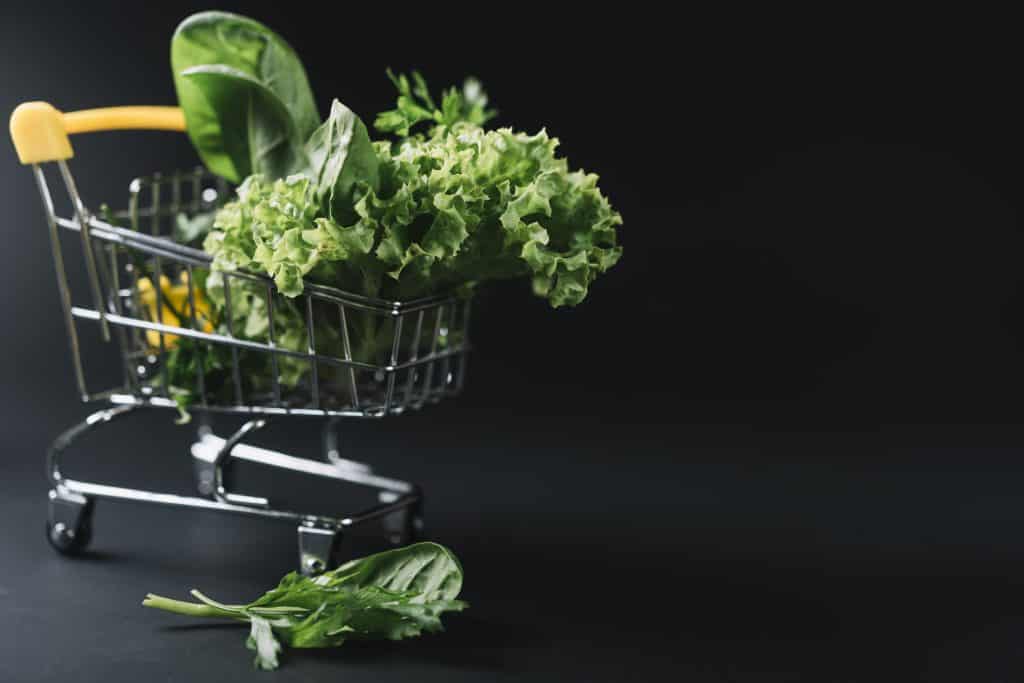
Leafy greens have a high amount of potassium, iron, calcium, magnesium, vitamins, and antioxidants in them.
So what are all the leafy veggies a dog can eat?
Leafy green can be served raw or steamed. Serving them raw will ensure your dog gets the most out of the veggies but you may venture in to steam them to introduce a bit of a variety to your dog.
Go slow on the quantity and the cut size, you don’t want him lying on the floor out of stomach ache. The key is to serve little at the beginning and observe your dog’s adaptability to the veggie.
Greens should not exceed 5% of your dog’s daily diet.
| Parameters | Answers |
| Calories/100 Grams | Spinach – 23 Calories Broccoli – 34 Calories Brussel Sprouts – 43 Calories Green Beans – 31 Calories Kale – 49 Calories |
| Permissible Quantity Per Day | Not more than 10% of Total Calories Per Day. |
| How To Serve? | Boil the veggies and add small amounts finely chopped into meals. |
| Signs of Discomfort | Vomiting, Lethargy, and Nausea. |
Carrots
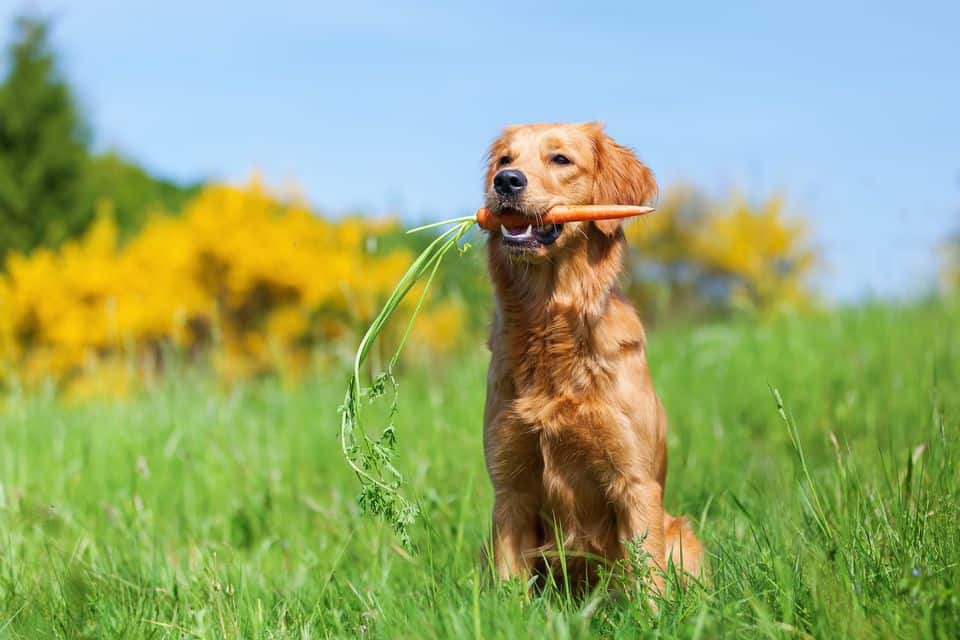
Carrots are low in calories and a good source of minerals, fiber, and vitamins like A, B, C, D, E, and K. Carrots are by far the best Human Foods Dogs Can Eat, especially for dogs who are trying to lose weight.
A carrot is known for having vitamin A in it which is true, a carrot can help to maintain the dog’s vision, bone growth, and immune system as well.
A carrot keeps the dental health of a dog maintained and is often suggested by vets during the teething period to keep the dog healthy and satisfied at the same time.
Carrots are by far the best Human Foods Dogs Can Eat.
A carrot can be served:
- By cutting them into bite-size pieces or
- By freezing bite-sized pieces and serving as a quick snack
- Grating on normal dog food
Carrot is a good go-to option for diabetic dogs as it is too much food and too few calories.
If you see any carrot pieces in your dog’s stool then cut the carrot finer or grate it before serving.
| Parameters | Answers |
| Calories | 100 Grams – 41 Calories. 1 Medium – 25 Calories. |
| Permissible Quantity Per Day | Not more than 10% of Total Calories Per Day. |
| How To Serve? | Grate or Peel Them. Juice Them. Bake Them. Freeze Them. |
Corn and Sweet Corn

Corn is a perfect snack for your dog although corn on the cob is not at all a good idea, as your dog might choke on it.
It contains vitamins like B, C, K, and E. It has folic acid and selenium in it which are good for your dog’s health. Most of the dog foods contain some amount of corn in it.
But this does not mean you serve them this daily, a bit off your plate is good.
| Parameters | Answers |
| Calories | 100 Grams – 86 Calories. 1 Cup – 132 Calories. |
| Permissible Quantity Per Day | Not more than 10% of Total Calories Per Day. |
| How To Serve | Sprinkle on top of the dog food. |
Did You Know?
- Corn has about 800 kernels in one piece!
- In Taino language corn means “Giver of Life”
- It comes in Red, Blue, Black, Green and Yellow colors.
Bell Peppers

Bell peppers are a very good source of beta carotene and vitamin C. The beta carotene in it keeps the eye health in good condition, your dog will be at a reduced risk of cataract and epilepsy.
Bell peppers have tough outer skin so don’t be surprised if your dog doesn’t like the veggie and spits it out.
Alternatively, you may puree it and feed them but don’t exceed more than 1 bell pepper in a day or 2.
It has a lot of fiber which may lead to diarrhea.
| Parameters | Answers |
| Calories | 100 Grams – 40 Calories. 1 Pepper – 18 Calories. |
| Permissible Quantity Per Day | Not more than 10% of Total Calories Per Day. |
| How To Serve | Steam them and sprinkle on top of the dog food. |
Zucchini

Zucchini is full of nutrients and minerals and on the other hand, doesn’t have a lot of calories to it which makes it a low-calorie food.
It can be a good snack but don’t switch to a diet with only zucchini in it.
Due to its low-calorie count, it is perfect for diabetic dogs and also one of the best Human Foods Dogs Can Eat?
| Parameters | Answers |
| Calories | 100 Grams – 17 Calories. 1 Medium – 33 Calories. |
| Permissible Quantity Per Day | Not more than 10% of Total Calories Per Day. |
| How To Serve? | Steamed Barbecued Baked Microwaved BoiledGrilled |
Green Peas (Sugar Snap Peas, And Garden Or English Peas)

Peas are rich in vitamins A, K, and B. They also are good sources of Fiber, Iron, Zinc, Magnesium, and Potassium.
How to serve peas to dogs?
- Wash them and serve directly
- As a frozen treat
- In a meal
| Parameters | Answers |
| Calories | 100 Grams – 81 Calories. 1 cup – 145 Calories. |
| Permissible Quantity Per Day | Not more than 10% of Total Calories Per Day. |
| How To Serve | • Wash them and serve directly • As a frozen treat • In a meal |
Cucumber

Cucumbers are one of the best human foods dogs can eat. They are 93% water and can be an excellent low-calorie treat. Cucumbers are by far the best Human Foods Dogs Can Eat especially for dogs on diet.
They are the best thing if your dog is on a diet and wants to lose weight.
| Parameters | Answers |
| Calories | 100 Grams – 16 Calories. |
| Permissible Quantity Per Day | Not more than 10% of Total Calories Per Day. |
| How To Serve | Cut into small pieces and serve. Grate over dog food or any other recipe. |
Strict No! No!
Asparagus, Mushrooms, Onions, Potatoes, Tomatoes, Garlic, Chives
Dairy For Dogs

This is a relative question, some dogs have no problem digesting while some experience symptoms like vomiting, diarrhea, nausea, and gas. The constituent called lactose might not digest in case of these dogs and hence any food item with lactose should be kept out of reach as they cannot produce lactase which is a digestive enzyme that reduces lactose in the stomach.
So strictly speaking it actually depends on the amount of lactose in a food item, if your dog is not reacting on feeding a small amount of dairy but showing any of the non-adaptive symptoms when consuming a lot, then you should note this and feed them minimal diary. If he/she doesn’t show a lot of problems even on serving a lot then you are good to go!
So the next list Human Foods Dogs Can Eat is the dairy products list for a dog:
Milk

So, can dogs drink milk?
Milk is rich in Vitamin D and calcium, it helps your dog’s teeth, and bones to grow stronger and healthier.
Most of the dogs can digest milk and it doesn’t create a lot of fuss!
Dogs should be fed cow’s or goat’s milk preferably to avoid any problems.
Start by feeding a lesser amount and then gradually increase it, do not feed any human food in abundance.
| Parameters | Answers |
| Calories | 1 Cup –103 Calories. |
| Permissible Quantity Per Day | According to AKC a few tablespoons of milk occasionally is a nice reward. Do not give a bowl full of milk as it leads to discomfort in dogs. |
| How To Serve? | Pour it into a bowl for direct consumption. |
| Signs of Discomfort | Loose stools, Gas, Vomiting, Abdominal pain, and Diarrhea |
Cheese

So, can dogs eat cheese?
Cheese is rich in protein, calcium, vitamin D, and essential fatty acids.
Also, cheese is a great training treat and is low on lactose at the same time but high in fat.
A little bit of cheese here and there is not a problem.
But keep your canine friend away from the following cheese:
- Blue cheese, Roquefort, and other French cheeses
- Cheese with herbs, garlic, or other flavorings
- Brie, goat cheese, and feta cheese
The above cheese is toxic for your dog, they might lead to vomiting, gas, and diarrhea.
Which cheese is good?
- Mozzarella
- Cottage Cheese
- Soft Goat Cheese
The key here is to feed low-fat cheese with no additives.
| Parameters | Answers |
| Calories | Mozzarella Cheese: 100 Grams – 280 Calories. 1 Slice – 28 Grams. Cottage Cheese (Best Cheese For Dogs): 100 Grams – 98 Calories Soft Goat Cheese: 28Grams/Ounce – 102 Calories. |
| Permissible Quantity | 3-4 small pieces weekly thrice are enough |
| How To Serve? | Serve small pieces directly. You may insert a tablet but not antibiotics! |
| Signs of Discomfort | Abdominal pain, Bloating, Dehydration Diarrhea, Excessive thirst, Vomiting Weakness, and Weight loss. |
Yogurt and Buttermilk

Yogurt and buttermilk have probiotics in them which make them a very good choice to feed to your dogs. They are rich in calcium and protein as well.
The right quantity should be no more than 10% of your dog’s diet.
Keep your dog away from yogurt or buttermilk which comes with added flavors or xylitol.
| Parameters | Answers |
| Calories | Yogurt: 100 Grams – 59 Calories. Buttermilk: 1 Cup – 152 Calories. |
| Permissible Quantity | 1 small cup of yogurt alternate days. 1 small cup of buttermilk alternate days. *Serve any 1 type of probiotic per day. |
| How To Serve? | Serve it directly or with rice. |
| Signs of Discomfort | Abdominal pain, Bloating, Dehydration Diarrhea, Excessive thirst, Vomiting Weakness, and Weight loss. |
| Best Sources Of Probiotics For Dogs |
| Yogurt Soft Cheeses Buttermilk Kefir Cultured Cottage Cheese Probiotic Supplements |
Ice Cream (Only Dog Friendly)

So from funny dog videos like the following, you might be tempted to give your dog ice cream.
But is ice cream for dogs safe?
Ice cream is not safe for dogs especially the one humans eat but there are alternatives to ice cream available in the market. You can also opt for a frozen yogurt treat or homemade cold treats for dogs.
| Parameters | Answers |
| Calories | Vanilla: 100 Grams – 207 Calories. Strawberry: 100 Grams – 192 Calories. |
| Permissible Quantity | 2 scoops in a week are more than enough |
| How To Serve? | Serve it directly or with rice. |
| Signs of Discomfort | Abdominal pain, Bloating, Dehydration, Diarrhea, Excessive thirst, Vomiting Weakness, and Weight loss. |
Meat, Poultry, and Seafood

Chicken

There is no debate in how the chicken is by far the best Human Foods Dogs Can Eat, but is it?
Cooked chicken is high in protein, omega 6, and has loads of energy!
Chicken helps in keeping the coat of a dog smooth and shiny.
When it comes to making chicken which healthy and safe for dogs to eat, it is almost a new blog topic that you can explore here. But the key is to keep them away from raw chicken, as it has a probability of holding bacteria and bones in it, you should avoid giving bones to dogs as they can cause choking or GIT (Gastrointestinal Tract) puncture.
Chicken is the third most allergic food in the canine world!
| Parameters | Answers |
| Calories | 100 Grams – 239 Calories *Chicken legs should be avoided as they are high in fat and have bones. |
| Permissible Quantity | This depends on the type of the dog, consult your vet. Generally, small amounts of cooked chicken every day in the meal is advisable. |
| How To Serve? | Boiled Shredded Barbecued Baked *Use chicken breasts and minimal oil if required. |
| Signs of Discomfort | Vomiting, Abdominal pain, Loss of appetite, Bloody stool, Lethargy, Constipation. |
Suggested: 9 Homemade Chicken Recipes For Dogs.
Eggs

Eggs are a very good option for dogs to eat, they have a lot of protein in them with fat-soluble vitamins, amino acids, and fatty acids which help in keeping the coat shiny.
So, can dogs eat eggs?
Yes, if you are serving them boiled or cooked and not raw, also without added flavors and eggshells.
| Parameters | Answers |
| Calories | 1 Large – 72 Calories Egg White – 17 Calories Egg Yolk – 55 Calories |
| Permissible Quantity Per Day | 1 Large Egg |
| How To Serve? | Boiled Scramble and add to daily meals Omelets with very less oil |
| Signs of Discomfort | Bald patches, Chronic ear infections, Chronic gas, Chronically inflamed feet, Coughing, Face rubbing, Vomiting, and Wheezing. |
Turkey
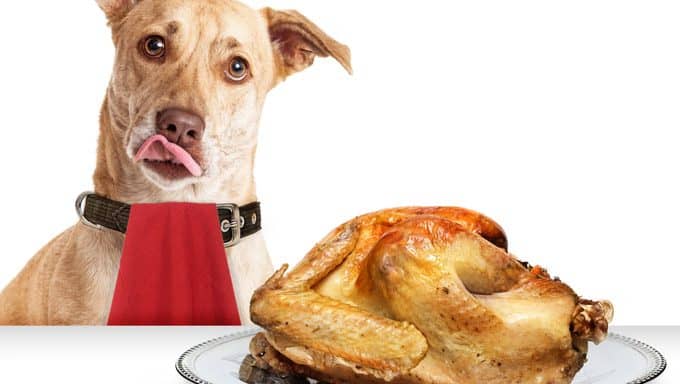
Cooked boneless turkey which is not added with any additional spices and flavors is safe for a dog.
So is it safe for dogs to eat leftover turkey?
No, because it has all the spices which can upset the stomach of your canine friend.
Turkey is actually included in a lot of dog foods because it has a lot of health benefits for them. While feeding any bird avoid the fatty areas like the meat near the legs to keep your pup lean, also white meat will be the perfect choice to feed your dog.
So can dogs eat turkey?
Yes, only it should be boneless and without and added spices.
| Parameters | Answers |
| Calories | 100 Grams – 189 Calories. |
| Permissible Quantity Per Day | This depends on the type of the dog, consult your vet. Generally, small amounts of cooked turkey every day in the meal is advisable. |
| How To Serve | 1. Remove the skin 2. Boil, bake, or Barbecue and 3. Serve only the meat without bones. *Do not feed turkey from the table, the spices are not good for your dog. |
| Signs of Discomfort | Mouth and tongue injuries Obstruction of the throat or intestinal tract Choking Bone fragments can pierce the lining of stomachs and intestines Constipation Rectal bleeding from sharp bone fragments Blockages that require emergency surgery |
Beef

Beef is an excellent option for dogs to eat. It is not as high as pork in fat content and doesn’t attract any health hazards as well.
It is rich in protein, minerals, vitamins, and omega 3 fatty acids which fall under the good fat category.
It can be included in their meal and is often already a part of a lot of dog foods that are sold in the market.
You should feed cooked beef without any traces of bones, you may also feed ground beef, and remove the excess fat or the skin from the meat.
So, can you feed your dog beef?
Yes, but make sure if the beef is not grounded, it should be cut into small pieces and you should only give with cooked beef without spices and bones.
| Parameters | Answers |
| Calories | 100 Grams – 250 Calories. |
| Permissible Quantity Per Day | This depends on the type of the dog, consult your vet. Generally, small amounts of cooked beef every day in the meal is advisable. |
| How To Serve | 1. Remove the skin 2. Boil, bake, or Barbecue and 3. Serve only the meat without bones. *Do not feed beef from the table, the spices are not good for your dog. |
| Signs of Discomfort | Diarrhea with or without blood and/or mucus in stool. Straining to pass stool. Vomiting. Abdominal pain. |
Pork

Pork is a good source of Protein, Vitamin B12, and a lot of fat! Apparently it is not the best Human Foods Dogs Can Eat, only because of the fat content in it but small amounts of pork here and there is not a problem.
Dogs can eat pork without the bones, the pork should be cooked and not raw. If you see symptoms like upset stomach, vomiting, diarrhea, lethargy, pain, elevated fever, and stiffness.
Pork contains a specific type of fat that can cause trouble in digestion for your dog. It is good to start a bit slow with lesser quantities and observe the behavior of your dog.
Unlike chicken and beef, pork is high in fat so don’t depend on this meat too much.
So, can dogs eat pork?
Yes, but it should be cooked without spices, without the bones and not too much.
| Parameters | Answers |
| Calories | 100 Grams – 145 Calories. |
| Permissible Quantity Per Day | This depends on the type of the dog, consult your vet. Generally, small amounts of cooked pork every day in the meal is advisable. |
| How To Serve? | 1. Remove the skin 2. Boil, bake, or barbecue and 3. Serve only the meat without bones. *Do not feed beef from the table, the spices are not good for your dog. |
| Signs of Discomfort | Upset stomach, Vomiting, Diarrhea, Elevated fever, Lethargy, Muscle inflammation, Pain & stiffness. |
Suggested: A Guide To Homemade Dog Food.
Seafood

Seafood is generally rich in amino acids and omega 3 fatty acids. Dogs love the taste of fish!
Tuna, Salmon, Whitefish, Ocean Whitefish, Lake Whitefish, Herring, Walleye, Flounder, And Arctic Char, Cod and Whiting/Hank are some of the fishes you can feed your pup.
Dogs should not be given uncooked fish as it might contain bacteria that is bad for their health. Also, before you give your dog a cooked fish make sure that there are no traces of bones in it, as fish bones are very thin and can easily miss out from your eye. Bones if ingested can cause a lot of problems for your doggie like choking, bleeding gums, or harm any of the organs.
Plain, cooked, steamed, grilled fish is completely fine for dogs in moderate quantities
So, is it safe for dogs to eat seafood?
Yes, but make sure that you are serving the fish cooked, deboned, and without any spices.
Strict No! No!
Raw Eggs, Fish or Meat Bones
Other Foods For Dogs:

Peanut Butter
Peanut Butter can be safe for dogs, it is rich in Vitamins E and B, protein, and monounsaturated fats.
Only unsalted and unflavored peanut butters are good for a dog.
When it comes to peanut butter, a lot of companies out there add salt, xylitol, and fats like palm oil. Keep your pooch away from these by carefully reading the content on the box or make peanut butter at home.
When it comes to the quantity either ask a vet or go for a 10% calorie from the human food method.
| Parameters | Answers |
| Calories | 100 Grams – 588 Calories. 2 Tbsp. – 188 Calories. |
| Permissible Quantity Per Day | 1 – 2 teaspoons |
| How To Serve? | 1. Give directly 2. Stuff peanut butter into a Kong |
| Signs of Discomfort | Gastric distress, skin irritation or hair loss |
You may also use Peanut Butter to cut the nails of your dogs.
Wait, what?
Here is a video that will explain the weird connection of Peanut Butter and nail cutting of a dog.
Brown & White rice
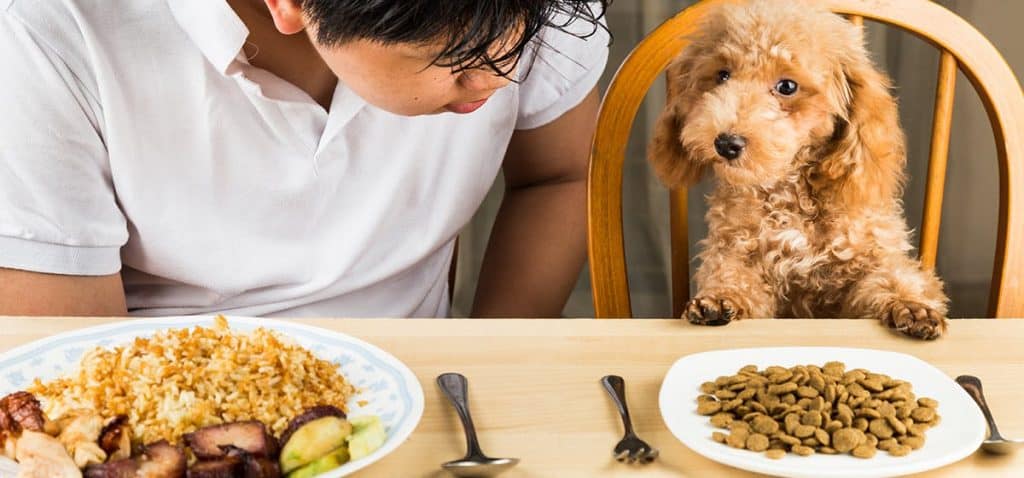
Rice is rich in carbs, Vitamin D, Thiamine, Niacin, Riboflavin and Calcium. It also contains a lot of starch which helps in growing good bacteria and supports bowel moments.
Yes, you can feed your dog white and brown rice, and that too daily except for a diabetic dog.
Rice is low in fats which makes it a good option for daily dog diet.
When it comes to choosing the best between white and brown rice, brown wins the race!
But stay away from brown rice if he has gastrointestinal issues. Since brown rice is a bit heavier than white rice and also low in starch, it demands more time and energy for digestion.
Also, if your dog is fat or obese then rice might not be the best option, a little here and there doesn’t hurt.
| Parameters | Answers |
| Calories | 100 Grams – 111 Calories. 1 Cup – 216 Calories. |
| Permissible Quantity Per Day | The calories from the rice should make up no more than 10 percent of your dog’s daily calorie amount. |
| How To Serve? | Cook or steam in water and serve directly or with chicken. |
| Signs of Discomfort | Gastric distress, skin irritation, or hair loss. |
Popcorn

Popcorn contains phosphorous, magnesium, manganese, zinc, and fiber.
It is very difficult to say no to your dog when you two are enjoying a nice movie by sitting on the couch.
So, can dogs eat popcorn?
Yes and no!
Yes, if you are giving them unsalted, air-popped popcorn and
No, if you are giving them buttered, salted, spicy popcorn with partially or kernels which didn’t pop.
| Parameters | Answers |
| Calories | 1 Cup – 30 |
| Permissible quantity Per Day | 1 small bowl of popcorn twice is more than enough. |
| How to Serve? | Air-popped without salt, remove unpopped kernels and serve one at a time. |
| Signs of Discomfort | Cramps, abdominal pain, and gas. |
Bread

The story of feeding bread to dogs goes exactly like in the case of humans, moderate is good.
There is no doubt that feeding bread dough is as dangerous as feeding garlic to a dog.
So, can dogs eat bread?
Yes, but only white and wheat bread. It should not contain additives like xylitol, garlic, or raisins.
| Parameters | Answers |
| Calories | White Bread 100 Grams – 265 Calories 1 Slice – 24 Calories Brown Bread 100 Grams – 293 Calories 1 Slice – 73 Calories |
| Permissible Quantity Per Day | 1 slice thrice a week is okay considering the bread doesn’t have raisins, garlic, nuts, xylitol, or artificial sweetener. |
| How To Serve? | Small pieces of bread or with peanut butter. |
| Signs of Discomfort | Cramps, abdominal pain, and gas. |
Oatmeal
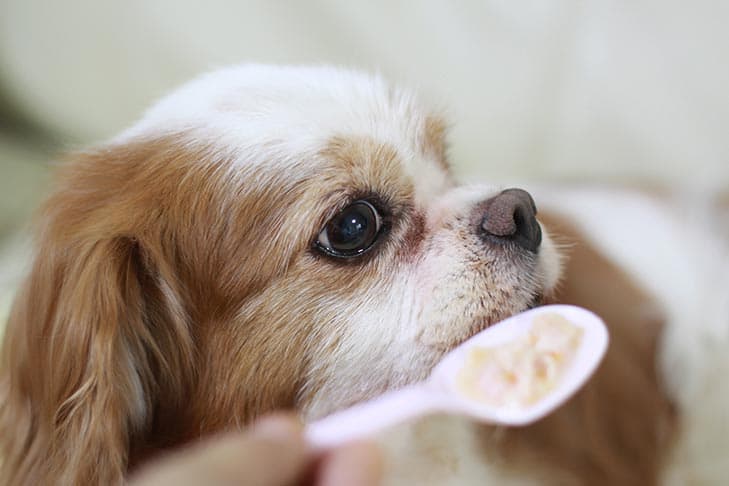
Oatmeal contains a lot of fiber, calcium, iron, and magnesium. It is one of the best Human Foods Dogs Can Eat!
While oatmeal is a great choice for people looking to lose weight and go slim, oatmeal does the same in the case of dogs with one small exception.
So, can dogs eat oatmeal?
Yes, only if it is cooked and homemade. It should have no toppings like cinnamon, sugary foods, nuts, etc. The oatmeal should be served at room temperature.
| Parameters | Answers |
| Calories | 100 Grams – 68 Calories 1 Cup(234g) – 158 Calories |
| Permissible Quantity Per Day | 1-2 times a week is more than enough for large dogs |
| How To Serve? | Cooked and not sprinkled with anything else. |
| Signs of Discomfort | Blotchy, irritated, itchy skin, rash or skin irritation on and in the mouth, scratchy throat, runny nose or nasal congestion, itchy eyes, Nausea, Vomiting, and diarrhea. |
Sweet Potatoes
Sweet potatoes are whole foods rich in calcium, potassium, iron, vitamins A, C, and B6.
They are surprisingly low in fat but still they are not the best for diabetic dogs.
So, can dogs eat sweet potatoes?
Yes, cooked sweet potatoes with peeled skin are a good nutritious add on for your dog’s diet.
| Parameters | Answers |
| Calories | 100 Grams – 86 Calories 1 Potato (130g) – 112 Calories. |
| Permissible Quantity Per Day | Start with 2 – 3 pieces and gradually increase. Weekly 1 sweet potato is more than enough. |
| How To Serve? | 1. Cook or Bake the potato 2. Remove the skin 3. Feed without any add on |
| Signs of Discomfort | Upset and inflamed stomach |
Quinoa

Quinoa contains saponin which can create problems in digestion. But on the other hand, it is a very good low-calorie dry food for your dog.
Quinoa should never be given to dogs directly from the plate, it may contain spices, garlic, onion, or anything which may cause problems in your dog.
So can dogs eat quinoa?
Yes, but wash it thoroughly to get rid of the saponin, cook it without spices and give it to your dog. Start slow and gently increase if everything looks good.
| Parameters | Answers |
| Calories | 100 Grams – 145 Calories. |
| Permissible Quantity Per Day | This depends on the type of dog, consult your vet. Generally, small amounts of cooked pork every day in the meal is advisable. |
| How To Serve? | Add one part quinoa to two parts liquid, and bring to a boil. Turn down heat to low, and cook, covered, until the liquid has been absorbed. *Do not serve hot, bring the temperature down |
| Signs of Discomfort | Vomiting, Diarrhea, or Constipation |
Strict No! No!
Cinnamon, Coconut products, Xylitol, Salt & Salty foods, Bread dough, Jam, Alcohol, Chocolate, Coffee and Tea, Garlic, Nutmeg, Lemons, and Limes
Snacks For Dogs
When you are looking for snacks for dogs you should be looking for healthy snacks for dogs, here are some healthy options:
- Peanut Butter
- Pumpkin
- Apple
- Cheese
- Green Beans & Broccoli
- Popcorn
- Carrots
- Red Peppers
- Green Peas
- Berries – Blue, Black, and Strawberries
This was our take on Human Foods Dogs Can Eat!
We hope you loved it. Please share it with dog parents and help their canine friends to live a healthy life!
Did we miss out on anything?
You can tell us about that in the comment section!












